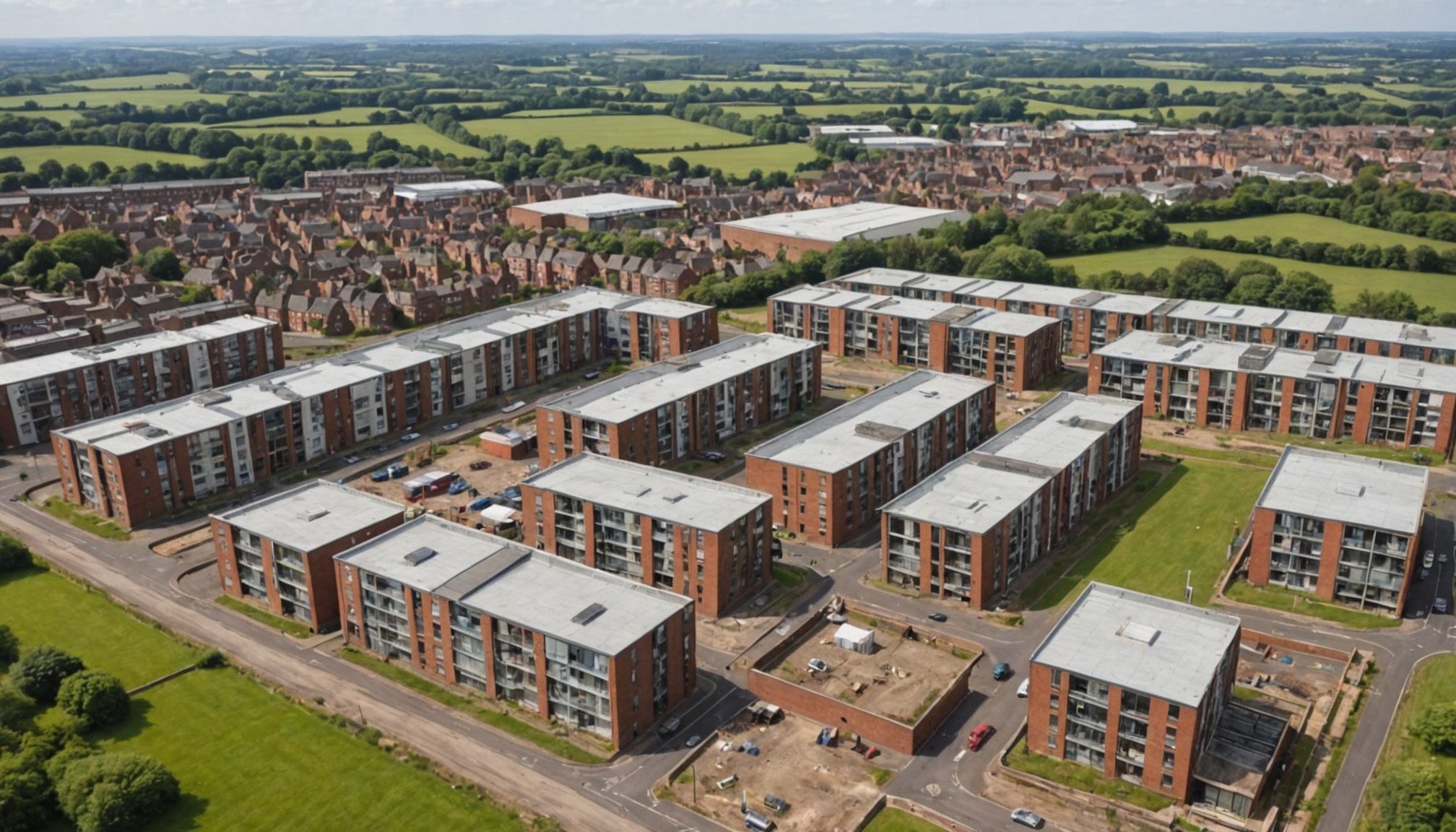Overview of Brownfield Development in the UK
Brownfield sites play a crucial role in urban development, offering an opportunity to transform previously used land into valuable housing spaces. These sites, often former industrial or commercial areas, can help meet housing demands while preserving greenfield spaces. Their redevelopment is central to UK housing policies, aiming to rejuvenate urban areas.
In the UK, several key policies encourage the redevelopment of brownfield sites. Notably, the National Planning Policy Framework (NPPF) emphasizes the efficient use of land, promoting brownfield development as a priority. Government incentives and funding schemes often support projects that utilise these underused spaces.
Topic to read : Unveiling the Financial Impact of Cultural Quarters on City Property Values
Current trends highlight a growing focus on brownfield land for housing development. Recent statistics indicate a significant portion of new housing projects now occur on previously developed plots. This trend supports efforts to limit urban sprawl and conserve open countryside areas.
While brownfield sites present challenges, such as contamination, they also provide opportunities for creative urban renewal. With effective UK policies and robust planning, these developments can meet housing needs sustainably and innovatively, benefiting communities and the environment alike.
Also to see : Unlocking Property Potential: A Deep Dive into Urban Green Spaces and Their Value Impact
Innovative Strategies for Sustainable Housing Development
Incorporating innovative strategies and sustainable housing practices is essential for creating lasting urban environments. A prominent approach is the use of eco-friendly materials and construction techniques. By selecting sustainable sources like bamboo or recycled steel, developers can reduce the carbon footprint of new constructions significantly. Such materials not only conserve resources but also improve energy efficiency.
Integrating green spaces within housing developments is another strategy gaining traction. These spaces, whether vertical gardens or communal parks, enhance urban biodiversity and offer residents areas to relax, promoting well-being. Smart planning ensures these spaces optimise natural light and air flow in homes, reducing energy needs.
Adoption of smart technologies further transforms housing projects. Intelligent systems control lighting, heating, and security, aligning with sustainable living aims. For instance, smart thermostats adjust temperatures based on occupancy, aiding in energy conservation. Coupled with renewable energy sources like solar panels, these technologies fortify sustainability credentials.
The synergy of these strategies delivers homes that are not only environmentally sustainable but also meet modern lifestyle demands. Through these efforts, housing developments on brownfield sites symbolise progress in urban planning while prioritising ecological balance.
Successful Case Studies of Brownfield Housing Developments
Brownfield projects in the UK showcase impressive urban renewal through successful case studies. Lessons learned from these developments offer valuable insights for future projects, demonstrating the transformative potential of brownfield sites.
High-profile examples of successful developments
A standout case study is the Kings Cross Central in London. Once an underutilized brownfield site, it has been transformed into a bustling urban oasis with mixed-use spaces, integrating housing, offices, and leisure amenities. This redevelopment highlights innovative strategies in brownfield projects, including eco-friendly design and smart technology utilization.
Meanwhile, Salford Quays illustrates the potential of brownfield sites. Once a derelict dockyard, it now thrives as a vibrant commercial and residential area, with renewed importance to the local economy. These successful transformations underscore the effectiveness of brownfield projects in revitalizing areas.
Lessons learned from various projects
Community involvement emerges as a critical component in these success stories. Engaging local stakeholders early in the process fosters community support and ensures projects meet resident needs. Additionally, thorough impact assessments and strategic partnerships with public and private sectors enhance project efficiency and sustainability, setting a precedent for future brownfield projects.
Environmental Considerations and Impact Assessments
Understanding the environmental impact of a project is critical before commencing with brownfield development. Comprehensive assessments ensure that potential contaminants are identified and addressed. Before any construction begins, developers should perform thorough environmental assessments to pinpoint pollutants common to brownfield sites, such as heavy metals and hydrocarbons. These assessments guide remediation practices, leading to safer and more effective site use.
Effective remediation involves techniques like soil washing, bioremediation, and containment. Soil washing eliminates contaminants via chemical solutions, while bioremediation uses microorganisms to break down pollutants naturally, promoting a sustainable approach. Containment prevents pollution spread, providing a cost-effective solution where removal isn’t viable. These varied techniques tailor responses to specific site conditions, ensuring effective environmental impact management.
Balancing development with ecological preservation is paramount. Developers must strive for harmony between construction practices and natural surroundings. This balance might involve creating green spaces, preserving existing flora, or enhancing local biodiversity. Pursuing ecologically sensitive designs not only pastures local wildlife but also highlights the commitment to sustainable urban renewal, reaping long-term environmental impact benefits on the community, the ecosystem, and the project itself.
Challenges and Benefits of Brownfield Development
Developing brownfield sites comes with its share of challenges and benefits, influencing the landscape of urban renewal. Among the primary challenges developers face are contamination and complex financing. These sites often harbour pollutants requiring meticulous remediation before any development can proceed. Financially, the initial costs of clean-up and the perceived risks may deter investors, complicating project viability.
However, the long-term benefits of redeveloping brownfield sites are significant. Transforming these underutilized lands rejuvenates urban areas and helps meet housing development demands. By doing so, the pressure on greenfield sites is reduced, preserving natural habitats. Urban renewal projects on brownfields often attract businesses, boosting economic growth and creating jobs.
Public-private partnerships are crucial in overcoming these challenges, as collaboration can ease both financial and logistical hurdles. Governments and private entities working together ensure projects receive sufficient funding and expertise. Such partnerships have proven successful in many UK projects, delivering significant community benefits and sustainable urban growth. A strategic approach that embraces these partnerships accelerates redevelopment and propels cities towards an environmentally friendly future. This cooperative model highlights the potential of brownfield redevelopment in reshaping modern urban landscapes.
Regulatory Frameworks and Policy Implications
Examining the regulatory frameworks surrounding brownfield redevelopment highlights key considerations for stakeholders. In the UK, various regulations govern the transformation of brownfield sites, ensuring that projects align with environmental standards and urban planning objectives. A primary framework is the National Planning Policy Framework (NPPF), which underscores the importance of efficient land use and prioritises brownfield development over greenfield alternatives.
Government support plays a critical role in facilitating successful brownfield projects. This includes providing essential funding through initiatives such as the Housing Infrastructure Fund, which aids in alleviating the financial burden associated with site remediation and preparation. These funding programs often incentivize developers to prioritise sustainable practices.
In anticipating future trends, policymakers are increasingly looking towards innovative strategies to enhance brownfield site utilisation. Emerging regulations may further streamline processes and offer additional financial incentives, fostering an environment conducive to urban regeneration. By staying attuned to policy frameworks and embracing supportive initiatives, developers and planners can overcome potential obstacles, contributing to sustainable urban growth. Proactive engagement with these regulations not only ensures compliance but also maximises the social and economic benefits of brownfield redevelopments.
Practical Guidance for Stakeholders in Brownfield Development
Embarking on brownfield redevelopment requires meticulous preparation and strategic planning from all parties involved. Stakeholders, including urban planners and developers, must navigate a complex landscape to ensure successful outcomes.
To start, a thorough assessment of the brownfield site’s condition is crucial. This includes evaluating the scope of contaminants and determining feasible remediation practices. Developing a comprehensive project plan with clear objectives and timelines paves the way for a structured approach.
Local community engagement is pivotal in securing trust and support. Engaging residents early through public consultations fosters transparency and aids in tailoring developments to meet community needs. Effective communication clarifies misconceptions, aligning resident expectations with project goals.
A wealth of resources is available to assist urban planners and developers. Government portals provide data on site conditions and prevailing UK policies affecting brownfield projects. Additionally, accessing environmental assessment tools and guidelines simplifies navigation of regulatory requirements.
Resourceful use of these tools ensures adherence to guidelines, promoting sustainable development. Through informed decision-making and a community-focused approach, stakeholders can transform brownfield sites into valuable assets for urban renewal, truly benefiting both the environment and local communities.





